Weekend Diversion: Superman vs. Baseball
With superhuman speed, strength and precision, how far could the man of steel hit a baseball?
“If I had to choose a superhero to be, I would pick Superman. He’s everything that I’m not.” –Stephen Hawking
And yet with all his superhuman abilities, what always set Superman apart in my imagination was his wisdom, kindness and compassion. It was how he used his abilities. Maybe Iron & Wine thought the same thing, when he covered the Flaming Lips’ beautiful song, Waiting For A Superman.
But with his incredibly accurate vision, his incomparable speed and strength, you’ve got to wonder, every once in a while, how Superman would do at a relatively “human” task. You know, like hitting a baseball.
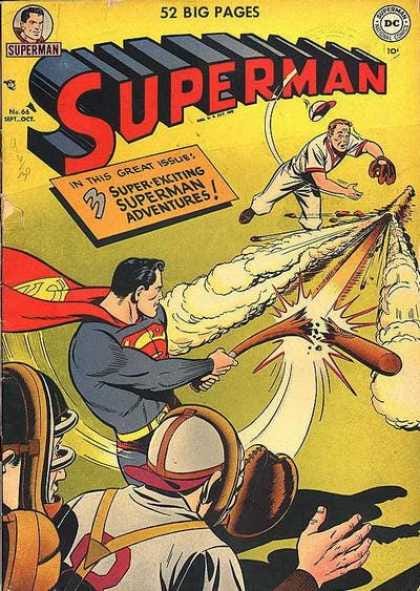
You might think he could hit a baseball into orbit, into another galaxy or past the edge of the Universe, but even Superman is constrained by a few things, including the laws of physics.
Let’s assume, for the purposes of answering this question, that Superman basically has unlimited strength and speed, but is limited instead by the following things:
- He has to use a regulation wooden bat to hit the baseball.
- He cannot break either the bat or the ball. (This is what you want; a broken bat fails to impart very much energy to the ball and a broken ball… well, that’s the end of your baseball.)
- No using super-breath, laser beams from his eyes, or any other superpowers to interfere.
- And finally, that even though he’s still Superman, the baseball is still subject to the normal laws of physics.
So given all of these things, how far should Superman be able to hit a baseball?
Let’s start with some basics from the guy who researches the physics of baseball: Dan Russell. We can immediately learn some wonderful things that are independent of Superman’s abilities. First off, the typical major league bat has a mass of about 0.9 kg, although they can be as massive as about 1.5 kg. The ball is between 142 and 149 grams, as per MLB regulations. Second, the difference in speed between the ball and the bat, in the end, is determined by the speed of the pitch, not the speed of the bat. For a baseball pitched at 90 miles per hour (40 meters/second), the difference between the final speeds of the ball and bat will be 0.55 times the difference between the initial speeds of the ball and bat.
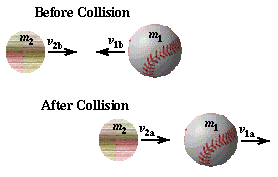
And for a normal human being (at least, a normal major league power hitter), there’s already been a study done where they’ve not only derived a formula for the final speed of the ball dependent on the initial speeds of the bat and ball:

But they’ve also determined what the optimal bat weight and swing is for someone who can make contact with a baseball, whose sole concern is how fast they can hit that baseball. Take a look at the graph below.
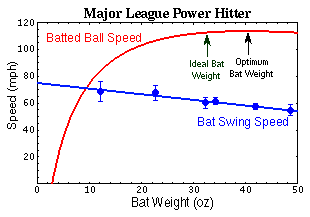
Of course, that’s for someone who’s, you know, a normal person. Someone who can swing a heavy bat slower than they can swing a lighter one.
That’s why the best part is now, when we get to have some fun. We’re not dealing with a Babe Ruth, Hank Aaron or Barry Bonds here. We’re dealing with Superman. If a normal human can deform a baseball like this:
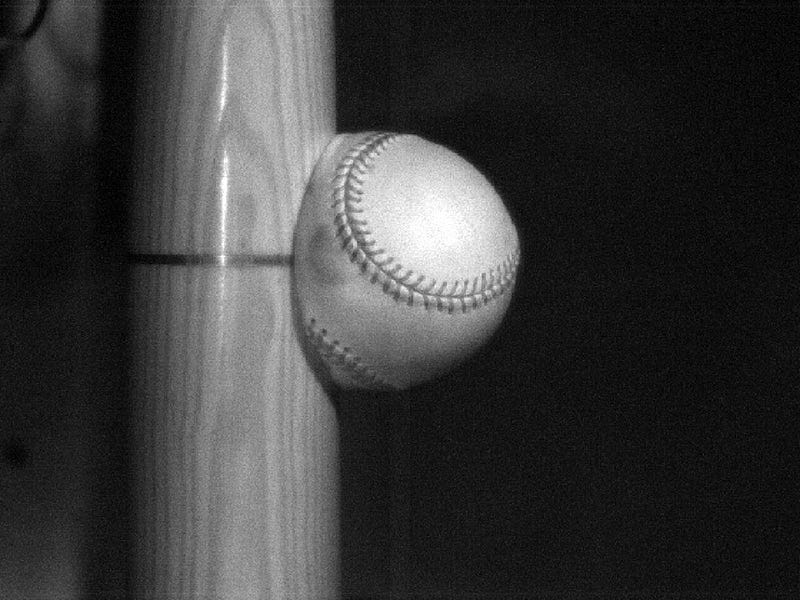
then it stands to reason that Superman will have to hold off, or the bat (and ball, for that matter) will be destroyed by the incredible forces he can exert. An important piece of information is that the contact time between the ball and bat is typically only 0.0007 seconds, and let’s assume that for Superman, it’s the same. The average force on the ball & bat? That just mass multiplied by the change in velocity, all divided by the contact time.
And so then what of the peak force? Easy enough: it’s twice that. So, if we can figure out how much force will destroy a bat or ball, and require that Superman swings no stronger than that, we can determine how quickly he launches that sucker.

White ash, the material that baseball bats are made out of, will rupture if you apply more than 15,000 pounds of force per square inch against it. Given that a baseball has a surface area of 26.4 square inches, and as you can see from a slow-motion camera shot of a struck baseball, about one-sixth of the ball comes in contact with the bat (and that’s being slightly generous), that means the bat can exert a maximum of 66,000 pounds of force on the ball without breaking, or 295,000 Newtons. This means we can get an average force out of about half that, or a maximum change in the ball’s speed of 712 meters/second.
This assumes that Superman hits the ball perfectly, dead center in the sweet spot of the bat. (And why not, really; after all, he is Superman.) That means the speed at which the ball leaves the bat is, maximally, about 672 meters/second, or around Mach 2. You know, the same as the maximum speed of the Concorde.
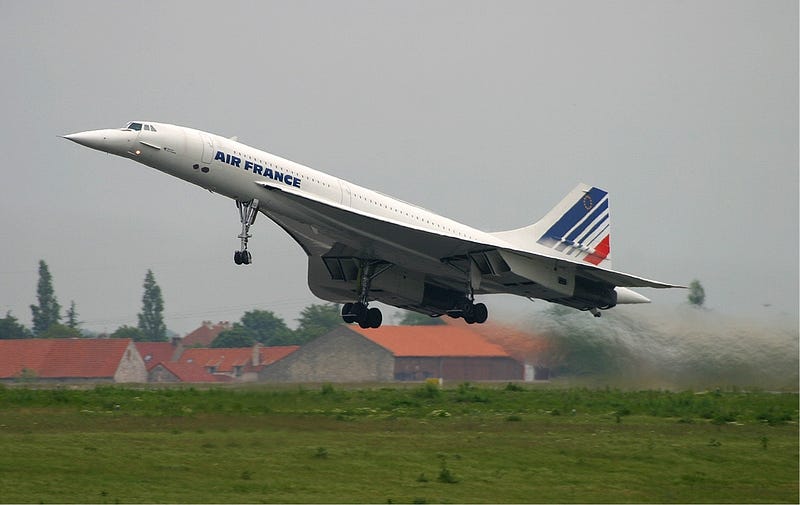
At these speeds, air resistance is definitely important, and can’t be neglected. In fact, the terminal velocity of a baseball is only about 33 meters/second, and we’re talking a speed more than twenty times that! Without air resistance, the ball would travel about 46 kilometers before coming down to Earth, a truly amazing feat. However, air resistance slows this thing down pretty quickly, as you can find out for yourself by working through the (awful) equations, or looking at a simple simulation that shows the (normal-speed) difference between trajectories with and without air resistance.

If you factor in air resistance at sea level, launching the baseball at 672 m/s at an angle of 45 degrees, the ball comes down after about 50 seconds, and lands “only” about 900 meters away from where it started, or about 3,000 feet away. Although that’s a titanic home run no matter how you slice it, that isn’t even a kilometer away! Still it’s maybe some six times as long as any home run hit in any recent season (see 2011’s home runs, below and left), and some five times as distant as Mickey Mantle’s legendary (and perhaps apocryphal) 1953 home run (below, right).
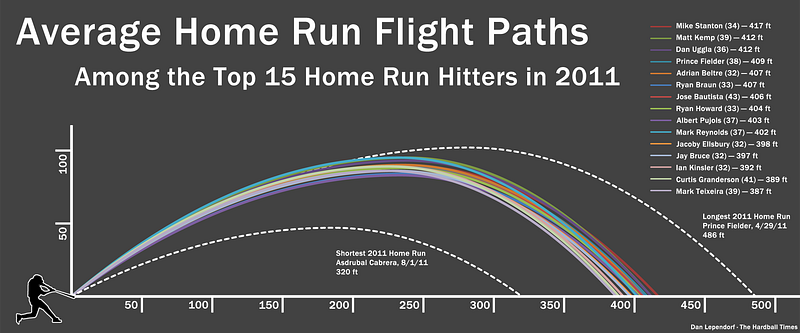
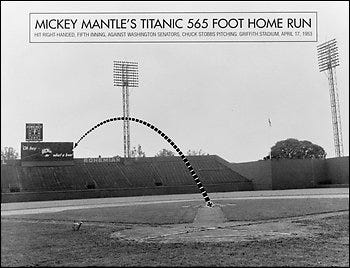
Because of this intense air resistance, though, smaller angles do better. By lowering the angle to only about 10–15 degrees, you can get the ball to go a little further: about 1,300 meters away, or close to a mile. If you happened to be playing at Coors Field in Denver, thanks to the increased elevation (and the resultant reduced air pressure), you can tack on about an extra 50% to that distance.

So for truth, justice, the American way and a sure spot in Cooperstown, make sure you pick the man of steel first when the draft comes around. But even in an ideal world, your baseball isn’t going to go as far as you might have imagined!
Leave your comments at the Starts With A Bang forum on Scienceblogs!





